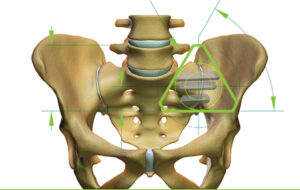SI Joint
A Minimally Invasive Surgical Option for the SI Joint. Unexplained Low Back and Buttock Pain? We Can Help!
The sacroiliac joint (SI joint) is located in the pelvis; it links the iliac bones (pelvis) to the sacrum (lowest part of the spine above the tailbone). It is an essential component for shock absorption to prevent impact forces from reaching the spine.
STOP SI Pain in its Tracks!
The SI joint is a significant cause of low back pain. Clinical publications have identified the SI joint as a pain generator in 33% of chronic low back pain patients. In addition, the SI joint is a pain generator in up to 43% of patients with continued or new onset low back pain after a lumbar fusion.


Like any other joint in the body, the SI joint can be injured and/or become degenerative. When this happens, people can feel pain in their buttock (and sometimes in the low back and legs), often causing them to sit on the pain free buttock. This is especially true while lifting, running, walking or even sleeping on the involved side. It is common for pain from the SI joint to feel like disc or low back pain. For this reason, SI joint disorders should always be considered in low back pain diagnosis.
If you experience one or more of the symptoms listed below, you may be experiencing SI Joint Dysfuntion.
- Low back pain
- Sensation of low extremity: pain, numbness, tingling, weakness
- Pelvis/buttock pain
- Hip/groin pain
- Feeling of leg instability (buckling, giving way)
- Disturbed sleep patterns
- Disturbed sitting patterns (unable to sit for long periods, sitting on one side)
- Pain going from sitting to standing
We perform a variety of tests during a physical examination that help reveal the SI joint as the cause of your symptoms. Sometimes, X-rays, CT-scan or MRI may be helpful in the diagnosis of SI joint-related problems. The most relied upon method to accurately determine whether the SI joint is the cause of your low back pain symptoms is to inject the SI joint with a local anesthetic. The injection will be delivered under either X-ray or CT guidance to verify accurate placement of the needle in the SI joint. If your symptoms are decreased by at least 50%, it can be concluded that the SI joint is either the source of or a major contributor to your low back pain. If the level of pain does not change after SI joint injection, it is less likely that the SI joint is the cause of your low back pain.
Treatment Options
Once the SI joint is confirmed as the cause of your symptoms, treatment can begin. Some patients respond to physical therapy, use of oral medications, or injection therapy. These treatments are often performed repetitively, and frequently symptom improvement using these therapies is temporary. At this point, you and your surgeon may consider other options, including minimally invasive surgery.
SI Joint Fusion with the iFuse Implant System®

The iFuse Implant System is designed to provide stabilization and fusion for certain SI joint disorders. This is accomplished by inserting triangular shaped titanium implants across the sacroiliac joint to maximize postsurgical stability and weight bearing capacity. The procedure is done through a small incision and takes about an hour. Multiple published studies on iFuse have documented procedure safety and effectiveness.
Possible benefits versus traditional SI joint fusion
- Smaller incision size
- No need for bone grafting
- Less soft tissue stripping
- Minimal tendon irritation
- Reduced blood loss
- Decreased OR time
